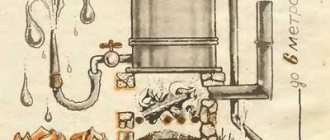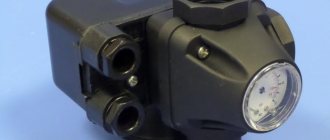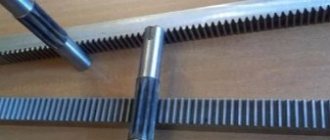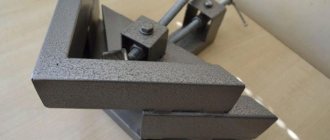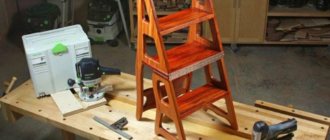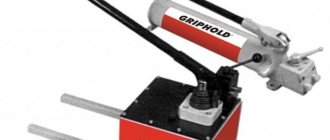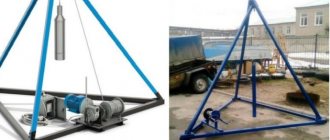A jack is one of the most essential items on every road trip. In the event of an accident in a sparsely populated area and the car service is remote, the lack of a jack can lead to big troubles.
- Anyone with the necessary experience can understand how to make a jack with their own hands
Popular types of jacks
Probably every good owner has a jack in his tool kit.
And those who often have to lift loads, repair a car, or change wheels know that, according to safety regulations, it is necessary to install several units of lifting tools for insurance. Of course, an ordinary solid object can be used as a backup option. For example, everyone is familiar with laying bricks. But such a makeshift approach simply cannot inspire the necessary confidence. Therefore, sometimes you can approach the issue of safety more thoroughly and make a homemade jack for the garage. Moreover, this work does not involve any special difficulties.
The following types are popular today:
- screw;
- rack and pinion;
- pneumatic;
- hydraulic.
Each type of jack has its own advantages and disadvantages. Some are simpler in design (and therefore easier to assemble with your own hands), while others are considered the most reliable and powerful.
Screw
The design of a screw jack is as simple as possible and time-tested. For this reason, these types are considered the most common. Often, it is precisely these jacks that are included in standard motorist kits.
But, despite the fact that they are easy to assemble, it will be very difficult to reproduce the mechanism yourself, because you will need to repeat the special thread pattern that is applied to the lifting lever and stop. The teeth are given a trapezoidal shape for the following reasons:
- such a thread has a self-extinguishing function (does not unwind under the influence of a load);
- the transmitting force is increased many times (use limits: from 500 kilograms to 10 tons), which ensures ease of operation.
Such lifting tools are no more expensive than other analogues, so there is little point in creating a homemade screw jack.
Rack and pinion
Rack structures are used primarily for lifting loads to great heights. They also have optimally calculated force.
The mechanism is also quite complex. The technological effectiveness lies in the fact that the lever gradually sets in motion the gear, which moves along a vertical rack with special locking holes.
It is difficult to make a rack structure with your own hands.
Pneumatic
Pneumatic or bottle jacks work on the principle of pumping compressed air into a special container, which squeezes out the rod and lifts the load. Such models have good load capacity, and the range is limited only by the length of the lifting rack.
You can make a homemade pneumatic design by purchasing only the main mechanism with compressed air. And it is quite possible to make levers and additional parts (wheels, stops) with your own hands, having previously calculated everything.
Hydraulic
Perhaps the best option for a do-it-yourself lifting mechanism is a hydraulic one. As a rule, the design involves the creation of a rolling mechanism on wheels and ease of lifting.
The principle of operation of a hydraulic jack is the same as that of a pneumatic one. It is not compressed air that lifts the rod, but oil, which has a low compression ratio. For this reason, hydraulic jacks are used in professional auto repair shops (some models are capable of lifting loads of up to 20 tons).
And, of course, if you reproduce the design in your own garage, you will get a useful and irreplaceable tool.
A container with oil and a lever for operation are purchased. And all other elements are designed as needed.
Homemade jack for raising a car: drawings and description of how to make
A jack is a device that no driver can do without when repairing their car. It is needed to lift loads to a small height. It should be stored in the trunk of a car or in a garage.
When purchasing such a device, you need to pay attention to the load capacity, which should be as high as possible, as well as the universal functionality. Many car enthusiasts prefer a hydraulic jack, which you can build with your own hands.
But before that, you need to study information on how to make a homemade car jack with your own hands at home.
Types of jacks
Today, the assortment of stores for car enthusiasts includes several types of jacks from both domestic and foreign manufacturers. Popular varieties:
- hydraulic;
- mechanical;
- electrohydraulic and electric;
- pneumatic.
The operation of a hydraulic lift is that it pumps brake fluid or hydraulic oil into the working cavity. Single-valve models have a valve that prevents oil from flowing back, and the two-valve type has a built-in bypass safety valve that prevents minor damage to the structure if the permissible load is exceeded.
Example of using a jack
A homemade mechanical jack is a lifting device for completing passenger cars. The principle of its operation is that the screw pin is moved by mechanical force.
As for the electro-hydraulic design, it is activated by an electric drive. There are some lift models that have a manual drive.
Rack and pinion jack in ancient times
The first devices were used by ancient warriors as siege weapons during the assault on fortresses. With the help of such devices they lifted the gates, threw them off their hinges and entered the settlement. The creator of the car jack is an employee of one of the American service stations named Peter Lunati. The idea arose when he saw how one hairdresser, before cutting his hair, raises the chair to the desired height by pressing a special lever. So in 1925, the world's first platform lift was created, operating thanks to a hydraulic system using a hand pump.
Rack and pinion jack today
Initially, the rack and pinion jack was used only as a lifting device for railway cars, but later, with the development of the automobile industry, it became firmly established among motorists and has so far, since 1905, had no equal. It is not often used for simple wheel changes. For this purpose, there are devices that are more compact and more convenient to use. Rack and pinion jack is the official name of the device. And those who are more familiar with it call it high jack.
Hi-Lift Jack can not only lift a car, but can also push, pull, support and move a heavy loaded car, work as a hand winch, press or stretcher. Where can all this come in handy? Yes, anywhere, from the garage when repairing the chassis or dismantling a beam, gearbox, engine, ending with complex off-road raids, where the Hi-Lift Jack is firmly established.
Correct name for rack and pinion jack
The rack and pinion jack has three names that are common in our everyday life, and in essence all of them are quite correct. And all because there are three different versions of the origin of the name of this instrument in Russian. They all sound the same, but are spelled slightly differently.
1. “Hijack” comes from the English slang hijack, which means to steal or rob. Off-road philologists tend to use the word “take away” more, since there is an expression in their circles “without hesitation, take away an SUV from dirty and snow-covered paws.” It sounds, of course, beautiful, but it looks like someone’s far-fetched invention.
2. "High Jack". Also a combination of two British words: high (high or high) and jack (jack). So we get the name “high jack” that is more plausible and applicable to the appearance. Although that’s not quite it either.
3. And finally, “hi-jack”, which came from simplifying the name of the Hi-Lift Jack brand itself and writing it in Cyrillic. By the way, the name of the brand itself cannot be directly translated. This is how Philip John Harrah’s jack, which initially bore the absurd, at first glance, name “sheep farmer’s jack,” came to be called, renamed more than once. And the device was named that way because it was intended for farmers as an assistant on the farm.
Types of rack jacks
All rack and pinion jacks can be electric or manual. Despite this difference, the principle of operation of the device remains the same. Thus, the ratchet mechanism interacts with the rack. The body is lifted and moved along the rail. There is a support and a lever here. There is also a mechanical casing that protects all parts from possible contamination.
Rack and pinion models are divided into two groups:
- gear – a handle with gears is provided here;
- Lever - these jacks are driven by a lever.
The simplest equipment lifts a weight not exceeding 8 tons. There are special models on sale designed to perform various construction work. Thanks to their complex design, they are able to withstand a weight of about 10 tons. This figure for single-stage varieties is 15 tons, and for three-stage varieties - 20 tons. Moreover, it will be possible to move the load horizontally and vertically.
The tool works when a certain force is applied to the corresponding mechanism. If necessary, it is even possible to lift the load directly from the ground. This is facilitated by a low pick-up.
The main disadvantage of all rack and pinion jacks is their impressive dimensions. Thus, equipment designed to handle loads of 5 tons weighs about 40 kg. Accordingly, it is not always convenient to use them at home.
High jack jack design (Rack and pinion)
A real SUV differs from a fancy crossover precisely in that it has a rack and pinion jack on its spare tire or on the expedition trunk. It makes no sense to construct a Hi-Lift Jack with your own hands. The price does not justify the means, and the requirements for materials are too high. But knowing how it works and understanding the rules for its use is useful and even necessary if you have an SUV in your garage.
The design of the universal jack is extremely simple. It consists of several main parts:
- Support shoe.
- Perforated strip.
- Lifting mechanism.
- Beak.
- Lifting handle.
Here is his diagram in the photo. Lifting mechanism. moves along the perforated rail, catching on the holes.
Best material, cast iron or steel?
Pretty simple, right? But the trick is that the composition of cast iron or steel for the manufacture of the device is strictly regulated. There are no secrets in its composition, but it is the successful proportion of material elements presented in the table that allows the jack to withstand high loads and serve for a very long time.
The Hi-Lift company produces several modifications of jacks, differing in the length of the perforated rail and the material from which the main structural elements are made. Roughly speaking, you can buy two types of Hi-Lift Jack - black and bright red. The difference is that the black hi-jack has a support shoe, a lifting mechanism. and the handle are made of stamped steel, and for red devices everything is cast from cast iron of a special composition.
Load capacity
When deciding which jack to choose, it is worth considering one of the main parameters - load capacity. Each model is designed for a certain weight, exceeding which is undesirable.
When choosing a jack for an ordinary class C passenger car weighing no more than 1200 kg, take the equipment’s load capacity at 1500-2000 kg. For a small car weighing up to a ton, a device with a carrying capacity of 1.2-1.5 tons is not recommended. It is not recommended to take a larger “reserve” - it is unlikely to be useful for such a car, and the cost will increase noticeably (and the dimensions will be larger).
Large vehicles (classes D, E and F, SUVs, trucks) require models designed to carry more weight. For a large passenger car, sedan, hatchback or crossover, the weight of which reaches 2 tons, choose a jack for 2.5-4 tons. For freight transport, equipment designed for 10-30 tons is selected, taking into account the weight of the vehicle itself and the cargo transported in the body.
DIY rack and pinion jack
What tools and materials will be needed
In order to make a jack, you must have the right tool. The first step is welding, since with its help the assembly will take place. It is desirable that it be a semi-automatic device with carbon dioxide. Then the seams will be much smoother and there will be no excess slag. Second, and no less important, is the grinder. It’s good if the assortment includes both small and large.
With their help you will cut blanks from steel. You will also need a drill, because you will have to make more than one hole. To easily process iron parts, you definitely need an electric sharpener. It is key in the fitting process. In addition, it is advisable to have hand tools: files, needle files, whetstones, hammers, screwdrivers, rasps, levers with a set of taps, sledgehammers, vices, etc. The more devices you have at hand, the easier the manufacturing process will seem.
The more tools you have, the easier and better the jack will be.
A lathe is an excellent assistant in any business, but not everyone has one. In principle, you can do it without it, but if you have such a unit in your garage or workshop, it will work out much faster. After all, with the help of a milling unit it is easy to turn or process any part. For example, a bolt or rod. In general, your own machine will be very useful.
It's also worth talking about the material. You can buy it at the market or at a scrap metal collection point. The second option is much cheaper, since at scrap yards all the metal is rusty and broken. It is not suitable for use, but it is perfect as a donor.
It is advisable, of course, to purchase more of everything. After all, depending on what kind of jack you want, you may need additional mechanisms or fasteners that you cannot make yourself. Therefore, be prepared to purchase some components from the market.
Making your own jack
This article will describe the process of making a simple rack and pinion jack.
Such a jack can lift a car or any other heavy thing. There is nothing complicated in the design; all dimensions are taken taking into account the available materials. Materials and tools used by the author List of materials:
— a piece of channel (for 200); — profile pipe (square, 40X20, wall thickness 2 mm); — steel strip thickness 8 mm; - bolts, nuts and other small items.
List of tools:
- welding machine; - Bulgarian; — drilling machine or drill; - spanners.
You will need a cut of a two-hundredth or larger channel with a length of 60 mm. It is possible to make such a part from a steel strip.
We mark 20x40 holes on the channel shelves with an allowance of 2-4 mm for the 20x40 profile pipe.
We cut out these holes using any available method. If necessary, process with a file.
A 20x40 mm profile pipe should pass freely through them.
We take a piece of half-inch water pipe with walls of 2-3 mm. Its length should be 5-6 mm greater than the width of the channel part.
We weld the tube to the channel.
Now you will need a strip 500 long, 60-70 wide, 8-10 mm thick. We mark the strip - there should be 200 or a little more at the edges, in the middle there should be 65-70 mm.
To bend a strip of this thickness, you need to cut it with a grinder to about half the thickness, after which it will easily bend in a vice.
We boil the strip bent in the shape of a P along the cuts for strength.
Now this part needs to be drilled or holes made in another way, for example, by burning holes with a torch with a diameter of approximately 20 mm.
The holes are ready. Now we can start assembling our structure. We make an axle from suitable round timber so that it fits into the welded tube; it can also be a pin or a bolt of a suitable size. We insert it into place and weld it.
This is what we got.
Now you need to make two clamps from the same strip 8-10 mm thick. Mark the holes for the profile pipe and cut it out.
In the U-shaped part we drill a hole with a diameter of 12-14 mm. We insert a rod into these holes and scald it.
You also need 4 nuts for 6.
They are needed to attach the springs. We weld 2 pieces onto the clamp and 2 pieces onto the channel.
We drill a 10 mm hole in the second clamp and bore it to an oval shape. We weld a 10mm bolt to the channel.
Now you need to make and weld a stop for the second clamp. Here it is made from a piece of thick-walled tube.
Final fitting.
The jack is almost ready.
All that remains is to weld a lever to the U-shaped part, and to the channel a bracket or shelf for attaching a hook or a platform for support when lifting weights. That's all. Good luck with your creativity.
Hydraulic cylinder press
February 14, 2016
Hydraulic cylinders are used in plunger and drive type presses. The modifications vary in diameter. It is also important to note that most models have hinges. If we consider devices for plunger modifications, they use special sleeves.
The linings themselves are made of honed steel. If we talk about hydraulic cylinders for drive presses, they have pistons of different diameters. The lower part of the rod of the models is made with internal or external threads. On average, a high-quality hydraulic cylinder costs around 7 thousand rubles.
Devices for 20 tons
Hydraulic cylinders of this type are manufactured for both plunger and drive presses. Their pistons are installed with a diameter of up to 50 mm. The cylinders themselves are made of heat-resistant steel.
Some configurations have a special seal. The thickness of the journal in this case depends on the width of the piston. The hinges for such models are of the spherical type. Some models have an intermediate stop.
On average, such a hydraulic cylinder costs about 7 thousand rubles.
Devices with welded stem
Hydraulic cylinders for this type of press are produced with a small diameter. Model pistons are usually designed for 20 tons. Some configurations use screw-mounted cylinders.
It is also important to note that there are modifications on the market with bonks. They are located at an angle of 90 degrees.
The average weight of a hydraulic cylinder and pump for a press of this type is around 20 kg, and it costs about 7 thousand rubles.
DIY additional accessories
A huge number of accessories that you can either buy or make yourself help to expand the functionality of the hi-jack. Their set is dictated by the needs of the driver and the parameters of the car. The trick is to use the lifting device. or dragging a car is possible on almost any surface. If there is sand or muddy clay under your feet, the additional support that comes with the jack will be useful, but instead of it you can use whatever you have at hand - a log, a stone, a wide board.
The beauty of the Hi-Jack is that it can work with any vehicle height, even raised SUVs. For this purpose, some accessories are also used that allow you to lift the body and lift the wheel off the ground, hooking the Hi-Jack directly to the wheel rim, metal bumper, power body kit or bump stop. The accessory attaches perfectly to the power bumper and does not take up space in the trunk; there is also a separate jack mount for a spare wheel, for an expeditionary trunk, or on the side of a pickup truck.
Air injection mechanism
If we are talking about using the device in a garage, or using it in a tire shop, then there is only one option. This is a compressor that runs on 220 volts. By the way, there are models of pneumatic jacks that can also use a compressor that pumps no more than 2 atmospheres and operates from the on-board vehicle network of 12 volts, but this option is good in nature when there are no other options for hanging the car.
A garage needs a reliable and efficient compressor, although almost all modern models provide a pressure of 6 atmospheres, which is quite sufficient for the operation of an air spring from a truck.
Safety during work
When using a rack jack, you must always be careful. Simplicity of design cannot guarantee absolute safety when working with heavy loads. Before you start lifting the car, you must make sure that the surface on which the jack stands is level and flat. You can equip your workplace with durable items that you have at hand. You should always remember that the slightest misalignment can cause the entire structure to collapse.
If something like this were to happen while working under a machine, it's easy to imagine the possible consequences. Neglecting basic safety rules can result in at least minor injuries. Before starting work, you must make sure that the car is on the hand brake and that the forward drive and central differential are locked. You need to make sure the soil is hard. If you have steel boots in your trunk, you can mount them on the wheels.
Making a homemade pneumatic jack
The base is made of sheet metal 10 mm thick with dimensions 400x400 mm. The tires were purchased from an online store. There are different sizes available, but this one was chosen because, according to the manufacturer's size, it fit the instep (high enough). You can use a different size, but you will have to adjust the size of the base to ensure a stable rise.
The pipe supplying air to the lift was used from an old central heating system (already bent) with a diameter of 1/2 inch.
Look for wheels, valves, gearboxes, connections in stores or bins.
The air supply from below is a pressure hose, but this can be done rigidly using a thin tube; in general, everything should fit comfortably under the car.
The entire structure after folding, that is, releasing air and blocking, is located at a distance of 12 cm from the ground to the upper plane.
A 10mm rod was used in the middle of the jack, bent in a circle and welded.
These types of jacks are used for quick repairs, usually tire replacements - for longer lasting, consistent vehicle maintenance you need to use rigid, mechanically locked jacks - even with a factory hydraulic "frog" piston sealant can leak.
As for the possibility of the hose jumping out, this issue can be resolved with the help of a throttle valve connected by a steel pipe with a gasket, which, in turn, eliminates the possibility of the hose breaking on the ground. It is also possible to install a safety valve against too high pressure, although this seems unnecessary.
Do-it-yourself rack jack repair
A rack and pinion jack is the dream of many car enthusiasts, but not everyone can purchase one due to its high cost. Having knowledge of mechanics and having drawings, you can make this type of device yourself. A homemade jack is much cheaper than purchasing a factory tool.
To make the tool yourself, two rack pipes are welded together. It is recommended to take all parts from durable steel. The welded parts should resemble a pyramid. Next, the base is made down and up from a steel sheet 5 mm thick. A hole must be made in the top sheet for the nut. A hole is made in the bottom sheet for the mechanical rod. It is necessary for rotation to occur.
Tool components
Only those who understand technology and know how to use diagrams will be able to repair a rack jack themselves. Rack and pinion types of devices represent a complex design, characterized by large dimensions and heavy weight. This may cause difficulties in carrying out repairs without specialists.
For long-term operation of the device, you must follow the rules for its use. During operation, the tool must be cleaned regularly. If the mechanism that operates during lifting becomes dirty, it is washed and thoroughly dried. No work can be done if the mechanism is not lubricated. This may cause the jack to fail before the end of its service life. For processing, only Teflon grease is used, silicone is also suitable, but not motor oil. It should not be used as it accumulates dirt. This will cause the device to stop working smoothly.
In harsh driving conditions and off-road conditions, a rack and pinion jack is an indispensable tool. Its service life and reliability of operation directly depend on compliance with the rules of use.
The jack is very effective for use in a car, as it is simple, reliable and easy to use.
One of the varieties is the rack and pinion jack.
This is a fairly simple design from a variety of lifting mechanisms. It consists of a perforated metal strip (the length may vary), handles, and a thrust pad.
The mechanism platform is located low to the ground, which is convenient enough for installation under a car; it lifts loads weighing from two to twenty tons.
The jack can work as a winch in a longitudinal position.
Built-in gears distribute different weights in the jack. First gear lifts loads of six tons. The second gear will lift weights weighing from six to fifteen tons. The third stage provides lifting of a load weighing more than fifteen tons.
Features of equipment operation
For a jack to be effective, reliable and durable, it must be used correctly. So, during the unfolding process, the supporting “heel” is carefully pushed deeper. Thanks to this, the device will be level and stable. Otherwise, it will tilt slightly, which means the load may move or fall out altogether.
Once the device is in the desired position, move the switch to the upper position, and then pull the lever up so that the “heel” rests on the weight. Only after this stage can you begin to climb.
When working with a jack, you should remember safety precautions. You should be on the left side of the tool and hold the lever with your right hand.
It is additionally taken with the left hand, placing the thumb on the side. In this case, you should make sure that your fingers do not touch the racks, and your head is not between the lever and the rack.
If these recommendations are not followed, finger injuries and concussions may occur.
The lever itself is gently swung up and down. If during operation it seems that the jack is slightly skewed, you should reinstall it and start over. After lifting the load, the lever is fixed in accordance with the diagram.
It is worth noting that lowering the load is considered a more traumatic procedure, so it is performed very carefully and slowly. Possible damage usually results from the key coming out. To avoid this, it is important to hold the lever firmly until the load touches the ground.
A rack and pinion jack is indispensable for every motorist. Such equipment is easy to make with your own hands using several steel pipes, sheets and fasteners. The finished product must be periodically cleaned of dirt by spraying with water from a hose. Such simple maintenance is sufficient for the proper functioning of the structure.
Operating principle
The operation of a rack jack is based on the gradual movement of the load between small and large platforms mounted on the rack. The pressure is transmitted using a connecting rod.
So, at the beginning of lifting the load, the handle is positioned strictly vertically, and the entire load is applied to a large platform. When the lever is lowered, the connecting rod begins to rest against a small platform, which in turn transfers the lifting load to the upper stop until the pin occupies the next hole in the rack. At this moment, the pressure on the small area stops. Then the handle rises again, and with it the lower stop (exactly one hole). This is what one lifting cycle looks like.
When lowering the load, everything happens in the reverse order, that is, by cyclically raising the lever. When the handle is in a horizontal position, the small platform takes the entire load. And when lifting, the large platform is lowered until the pin jumps into the adjacent lower hole. And, accordingly, with each lowering of the lever, the small platform lowers by one hole.
Application area
A rack and pinion jack is a multifunctional device, because a vehicle can be lifted in four ways. In addition, the device can replace a winch, clamp and even a press. Let's consider all the options for using the tool in more detail.
Advantages and disadvantages of a rack and pinion jack
The main advantages of the hi-jack are its excellent efficiency of up to 85% and a large load capacity of up to 15 tons. Load capacity depends on the number of steps. So a single-stage jack is capable of lifting up to 6 tons, a two-stage jack up to 15, and a three-stage jack up to 15 tons of weight.
Rack and pinion jacks also serve in service stations as durable and tireless assistants in working with trucks and SUVs of any weight. The only disadvantages of the Hi-Jack are its dimensions and considerable weight.
Lifting the machine by the power parts
Before lifting the car, place the jack on a hard surface. Jacking up a car by reinforced protruding elements such as sills and bumpers is, of course, the most obvious way to use a rack and pinion “comrade”. So, you can get the vehicle out of a deep and muddy rut or lift the front of the car, thereby simplifying the winch’s task.
Wheel lift
If your car is not equipped with reinforced structures, then a special accessory called Lift Mate, which is often included with the lift, will help you pull it out of any substance. This device is put on the “beak” of the lift and clings to the wheel rim with hooks hanging on rag slings. After this, the ascent is performed.
Special slings are used to lift the car by the wheel.
Helpful Hint: If the Lift Mate was not originally included with the jack, it can be purchased separately. In this case, you should give preference to accessories with rubberized hooks.
Jacking up the bumper
The device is suitable for almost all metal bumpers, under which it is impossible to install the “beak” of a jack.
There are situations when, in order to replace a damaged wheel, you need to lift the car by the bumper. But what to do if the latter is not able to withstand the weight of the car. In this case, another additional device will help you out - Bumper Lift. This device is a chain sling with an attachment to the “beak” of the jack and one powerful hook that can be used to grab the power elements under the bumper (frame, axles, etc.).
Helpful Hint: When purchasing a Bumper Lift, pay attention to its maximum load capacity.
Jack instead of winch
But this is not all the capabilities of Hi-Jack. The device can easily replace a hand winch and pull a car out of any dirty situation. Moreover, any car, since the load capacity of the device, depending on the material of manufacture, can reach three tons. In one approach you can advance the machine the length of the rack. True, this still requires a chain or cable, but those who go off-roading stock up on both chains and cables.
The rack and pinion jack does not require complicated maintenance; after use, it is enough to rinse it with water and lubricate the rubbing parts. There are also Canadian devices on sale, there are jacks made in China, and there are also domestic ones. However, the test of rack jacks showed the advantages and endurance of the proprietary Hi-Lift Jack device. The price of a cast iron jack is about 9 thousand rubles, and a stamped steel one costs several thousand less. A Chinese copy will cost 5-6 thousand. There is no point in taking risks. Happy roads and exciting off-roading to everyone!
Buying ready-made
How to choose a quality tool and what to look for when buying
In order to correctly choose a good and high-quality Hi-Jack jack, you need to know the list of existing models and the main characteristics.
It is important to choose a jack with the expectation that it will fit a specific car.
You need to start your selection with the fact that the hi-jack machine must have persistent power points by which the machine can be lifted with such a jack. If these points are not present, then the hi-jack in this case will be completely useless.
If there are points and the car is suitable for use, then you need to choose a model with a suitable working length. To do this, you can borrow a hijack from someone and try it out. The car must be placed on a level surface and a jack must be installed at the rear. Start lifting the car by the power step until the rear wheel lifts off the surface. In this case, there should be a power reserve of about 25 centimeters left on the power bar of the device. The minimum acceptable value is 15 millimeters. However, if the lifting mechanism has reached the top of the bar, then this jack size is not suitable for full work with this car.
It is also important to consider the size of the wheels. If during the operation standard wheels were installed, but soon, for example in the summer, there will be a need to install larger wheels, then this factor must be taken into account. Hi-jack is popular among off-road enthusiasts, and there you have to change tires often depending on various factors.
Hi-jack with red cast iron power bar
It is recommended to choose a hi-jack with a red bar. It is the most durable because the bar is made of cast iron. If the choice fell on a cheaper option with a black bar, then it is important to consider that its capabilities will be slightly lower.
Main manufacturers
When purchasing a rack jack, decide on several points at once: price, reliability, quality, size and conditions of use. There are an incredible number of jack manufacturers. But let’s say right away that the best option, of course, would be the original jack from the American manufacturer Hi-Lift. Yes, the price is steep (from 4000 UAH and above), but remember this saying: “I’m not rich enough to buy cheap things.”
If you are sure that you will not use the hi-jack so often and quite carefully, then there is a large selection of Chinese manufacturers. A more or less good option is Matrix. Such a rack and pinion jack can be purchased for thousands cheaper than a competitor from America. The choice is yours, dear friends. You should always test jacks and select them specifically for your specific needs.
In principle, there is another option that is less expensive financially, but which will “eat” a lot of your nerves and “drink blood” - build a jack on your own. Yes, among our people there are many “Kulibins” who will build something from the remains of something. But 90% of the time, it’s something that’s worth nothing and fails at the most crucial moment. So, friends, we recommend that you better purchase a jack in a specialized store. And, perhaps, further eliminate existing weaknesses.
Each type of car jack has its own functionality, its own characteristics and its own disadvantages. Moreover, most often it also has a specific area of work, which cannot be said about a truly universal device that has been produced by Bloomfield Manufacturing Company, Indiana, USA, for more than a hundred years. The device was developed and patented by engineer Philip John Harrah, who later founded a company to produce these magical and irreplaceable jacks.
Which to choose
When purchasing, first of all, you need to decide on the brand and dimensions of the device. Which one to choose? There are many manufacturers of rack jacks. But if you want to purchase a truly high-quality and reliable tool, then you will not find a better jack from the American company Hi Lift. This company has been producing rack and pinion jacks for over a hundred years, and their products are used by the most avid Jeepers.
Hi-Jacks are available in only two colors - black and red. They are made of high-strength cast iron and have several steel parts. Such jacks are considered the standard of reliability and quality. They cost, of course, a little more than models from other manufacturers, but they fully justify their price. At least modifications longer than 150 centimeters do not bend, unlike tools from Chinese manufacturers. By the name of the model you can determine its length. Thus, the Hi-Lift Jack HL-485 has a length of 48.5 inches (120 centimeters), and the HL-605 has a length of 60.5 inches (150 centimeters). These are the models that are most popular among off-road enthusiasts.
